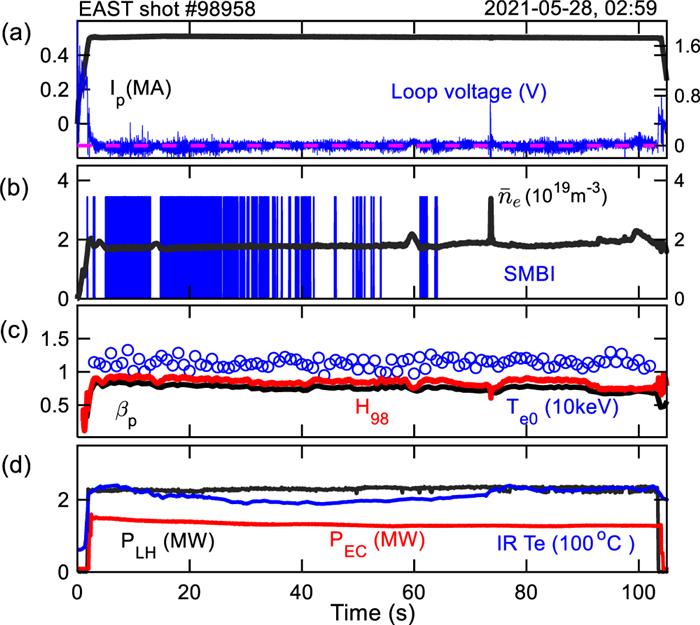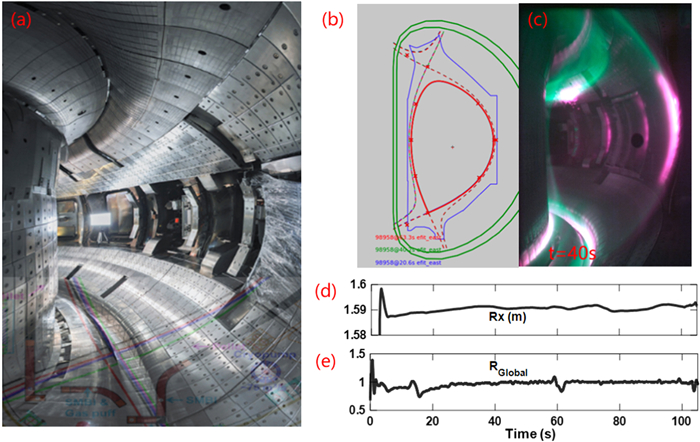
| Citation: | Xianzu GONG, Liqing XU, Jinping QIAN, Juan HUANG, Rui DING, A M GAROFALO, Annika EKEDAHL, Long ZENG, Erzhong LI, Bin ZHANG, Shiyao LIN, Biao SHEN, Mao WANG, Handong XU, Xinjun ZHANG, Miaohui LI, Guizhong ZUO, Qing ZANG, Haiqing LIU, Bo LYU, Liang WANG, Youwen SUN, Guosheng XU, Jiansheng HU, Damao YAO, Yu WU, Liqun HU, Bingjia XIAO, Nong XIANG, Kun LU, Yuntao SONG, Baonian WAN, Jiangang LI, the EAST Team. Realization of Te0 > 10 keV long pulse operation over 100 s on EAST[J]. Plasma Science and Technology, 2023, 25(2): 022001. DOI: 10.1088/2058-6272/ac9cc6 |
In 2021, EAST realized a steady-state long pulse with a duration over 100 s and a core electron temperature over 10 keV. This is an integrated operation that resolves several key issues, including active control of wall conditioning, long-lasting fully noninductive current and divertor heat/particle flux. The fully noninductive current is driven by pure radio frequency (RF) waves with a lower hybrid current drive power of 2.5 MW and electron cyclotron resonance heating of 1.4 MW. This is an excellent experimental platform on the timescale of hundreds of seconds for studying multiscale instabilities, electron-dominant transport and particle recycling (plasma-wall interactions) under weak collisionality.
The development of a high core electron temperature
In 2018, EAST realized this scenario of a normalized collisionality parameter
EAST is a medium-size non-circular tokamak with a major radius
Repeatable plasmas with
Figure 2(a) shows the new ITER-like lower tungsten divertor with flat structure, which enhanced particle and power exhaust capability during 100 s high
Because the RF coupling is very sensitive to the plasma density, the density control in long-pulse plasma operation is very important [15]. The EAST group made a big effort to achieve plasma density control with a timescale over 100 s. By means of the novel technique of injecting a Li aerosol into the edge plasma continuously and in real time combined with SMBI feedback [9, 16], the plasma density is well controlled in the long-pulse operation, as shown in figure 1. The green color in figure 2(c) indicates that a Li aerosol is injected into the edge plasma.
An excellent plasma shape control within a few millimeters is important not only to the RF coupling but also to the constant density control. Figure 2(d) indicates that the major radius of X-point is controlled within a range of a few millimeters. The recycling parameter below unity (figure 2(e)) during 100 s reflects a good maintenance of the plasma wall condition. The global recycling coefficient Rglobal is evaluated by equation [17]:
| dNedt=(Rglobal-1)·Neτp+f·qQinjection, |
where
The plasma current density consists of the Ohmic part (
Previous observations with EAST suggest that the existence of the m/n = 1/1 mode plays a key role in sustaining stationary high-
A steady-state long-pulse discharge with high-
The authors would like to acknowledge all of the EAST contributors and collaborators both domestic and international. The list of names can be found in the appendix at https://iopscience.iop.org/article/10.1088/1741-4326/ac2993. This work was supported by the National Key R&D Program of China (No. 2022YFE03010003) and National Natural Science Foundation of China (No. 12275309).
| [1] |
Xu L Q et al 2020 Nucl. Fusion 60 106027 doi: 10.1088/1741-4326/abadab
|
| [2] |
Huang Y H et al 2021 Nucl. Fusion 61 096026 doi: 10.1088/1741-4326/ac1199
|
| [3] |
Li E Z et al 2022 Phys. Rev. Lett. 128 085003 doi: 10.1103/PhysRevLett.128.085003
|
| [4] |
Nishizuka N and Shibata K 2013 Phys. Rev. Lett. 110 051101 doi: 10.1103/PhysRevLett.110.051101
|
| [5] |
Qiu Z et al 2018 Phys. Rev. Lett. 120 135001 doi: 10.1103/PhysRevLett.120.135001
|
| [6] |
Loureiro N F and Boldyrev S 2017 Phys. Rev. Lett. 118 245101 doi: 10.1103/PhysRevLett.118.245101
|
| [7] |
Diamond P H et al 2005 Plasma Phys. Control. Fusion 47 R35 doi: 10.1088/0741-3335/47/5/R01
|
| [8] |
Hu J S et al 2015 Phys. Rev. Lett. 114 055001 doi: 10.1103/PhysRevLett.114.055001
|
| [9] |
Gong X Z et al 2017 Plasma Sci. Technol. 19 032001 doi: 10.1088/2058-6272/19/3/032001
|
| [10] |
Wang H Q et al 2014 Phys. Rev. Lett. 112 185004 doi: 10.1103/PhysRevLett.112.185004
|
| [11] |
Wang L et al 2021 Nat. Commun. 12 1365 doi: 10.1038/s41467-021-21645-y
|
| [12] |
Wan B N et al 2013 Nucl. Fusion 53 104006 doi: 10.1088/0029-5515/53/10/104006
|
| [13] |
Gan K F et al 2013 J. Nucl. Mater. 438 S364 doi: 10.1016/j.jnucmat.2013.01.069
|
| [14] |
Yuan Q P et al 2020 Fusion Eng. Des. 154 111557 doi: 10.1016/j.fusengdes.2020.111557
|
| [15] |
Qian J P et al 2016 Plasma Sci. Technol. 18 457 doi: 10.1088/1009-0630/18/5/01
|
| [16] |
Zheng X W et al 2013 Plasma Phys. Control. Fusion 55 115010 doi: 10.1088/0741-3335/55/11/115010
|
| [17] |
Yu Y W et al 2019 Nucl. Fusion 59 126036 doi: 10.1088/1741-4326/ab3ead
|
| [18] |
Spitzer L 1962 Physics of Fully Ionized Gases 2nd edn (New York: Interscience)
|
| [19] |
Fisch N J 1987 Rev. Mod. Phys. 59 175 doi: 10.1103/RevModPhys.59.175
|
| [20] |
Rosenbluth M N et al 1972 Phys. Fluids 15 116 doi: 10.1063/1.1693728
|
| [21] |
Qian J P et al 2017 Nucl. Fusion 57 036008 doi: 10.1088/1741-4326/aa4e58
|
| [22] |
Jardin S C, Ferraro N and Krebs I 2015 Phys. Rev. Lett. 115 215001 doi: 10.1103/PhysRevLett.115.215001
|
| 1. | Liu, J., Liang, Y., Huang, J. et al. Research on stiff transport in electron heating dominated plasmas in EAST. Nuclear Fusion, 2025, 65(5): 056011. DOI:10.1088/1741-4326/adc4f8 |
| 2. | Yu, Y., Sun, H., Wang, C. et al. Removal of deuterium retention by various helium discharge cleanings under strong magnetic field in EAST superconducting tokamak. Nuclear Materials and Energy, 2024. DOI:10.1016/j.nme.2024.101834 |
| 3. | Wang, Z., Sun, Z., Zuo, G. et al. Fuel recycling feedback control via real-time boron powder injection in EAST with full metal wall. Plasma Science and Technology, 2024, 26(12): 125105. DOI:10.1088/2058-6272/ad811f |
| 4. | Ding, F., Zhang, Q., Hu, Z. et al. Divertor tungsten source monitoring by A visible spectroscopy diagnostic on EAST. Nuclear Materials and Energy, 2024. DOI:10.1016/j.nme.2024.101770 |
| 5. | Wang, S., Sun, Z., Qian, X. et al. Preliminary Design of Water-Cooling System for Liquid Metal Divertor Target Test Module in EAST. Journal of Fusion Energy, 2024, 43(1): 16. DOI:10.1007/s10894-024-00412-z |
| 6. | Liu, J., Zang, Q., Liang, Y. et al. Impact of T i/T e ratio on ion transport based on EAST H-mode plasmas. Plasma Science and Technology, 2024, 26(4): 045103. DOI:10.1088/2058-6272/ad1195 |
| 7. | Xu, W., Xu, H., Wu, D. et al. Advances and Prospects of ECRH System on EAST. IEEE Transactions on Plasma Science, 2024, 52(10): 5159-5172. DOI:10.1109/TPS.2024.3493092 |
| 8. | Wang, C., Yu, Y., Sun, H. et al. Design and implementation of intelligent control system for non-evaporable getter pumps. Journal of Physics: Conference Series, 2024, 2816(1): 012069. DOI:10.1088/1742-6596/2816/1/012069 |
| 9. | Zhang, Y., Zuo, G., Chen, Y. et al. Machine learning-based system for vacuum leakage detection in EAST fusion device. Fusion Engineering and Design, 2023. DOI:10.1016/j.fusengdes.2023.114070 |
| 10. | Hu, J., Xi, W., Zhang, J. et al. All superconducting tokamak: EAST. AAPPS Bulletin, 2023, 33(1): 8. DOI:10.1007/s43673-023-00080-9 |
| 11. | Li, M., Xu, H., Wang, X. et al. Plasma heating by electron cyclotron wave and the temperature effects on lower hybrid current drive on EAST. Nuclear Fusion, 2023, 63(4): 046019. DOI:10.1088/1741-4326/acbec9 |

